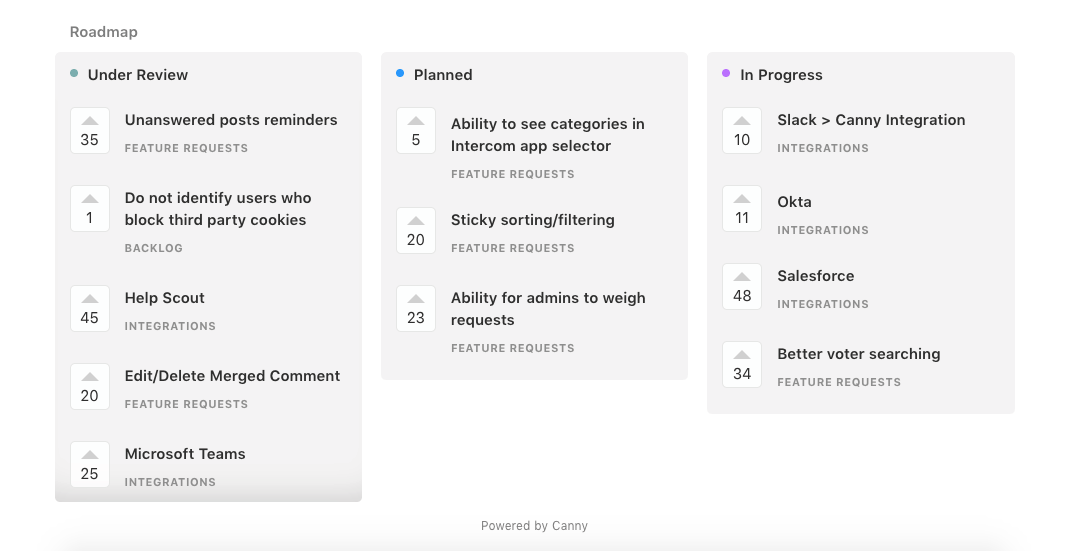With a public product roadmap, anyone can see what you’ve been working on.
Understandably, this can be a little nerve-wracking. You’re pulling the curtain back in a big way. Outsiders will now be able to see details of what your company is working on.
There are huge benefits to a public product roadmap—even if it feels a little intimidating.
Let’s explore how to overcome that fear and build public roadmaps your users are drawn to.
What is a public roadmap?
A product roadmap is a visual representation of your product’s direction, priorities, and progress over time. Roadmaps are a foundational product management tool.
A public product roadmap is the same, but it shares your product’s journey with the world. It’s a glimpse into what’s happening behind the scenes: upcoming features, bug fixes, and product updates. Public roadmaps invite your users into the planning process, fostering a community feel. It’s a living document that communicates the why, what, and when of product initiatives to internal teams, stakeholders, and customers.
This roadmap is open for everyone to see – users, customers, competitors, and more.
Why does it matter?
- Builds trust: shows you’re confident in your vision
- Vision sharing: it aligns your team and customers with the product’s long-term vision and every new feature
- Promotes transparency: makes users feel included and drives customer loyalty
- Feedback loop: opens a channel for receiving and integrating customer feedback directly into the product development cycle
- Prioritization: helps to make informed decisions on what to build next and focuses resources on high-impact features
- Expectation management: clearly communicates upcoming changes and features, manages customer expectations
So, with all these benefits, why wouldn’t you make your roadmap public?
Sometimes the roadmap’s contents aren’t fit to be shared publicly. A few examples could include:
- Plans that include proprietary or confidential information
- Roadmaps for products that only have internal use
- Top-secret projects that you can’t have a competitor learning about
You can probably think of many other examples warranting a private roadmap (aka internal roadmap).
When deciding whether to make your roadmap public, make sure you can tolerate the risks. Also, weigh them against the potential benefits.
Public roadmaps are critical for SaaS companies
Public roadmaps are useful for all types of companies, but critical for SaaS. SaaS customers expect regular feature development. They expect their feedback to be heard. And, they want to know when you work on their feedback and resolve issues. A public roadmap helps you satisfy all those expectations.
How do I build a public roadmap?
Building a public roadmap isn’t much different than building any other roadmap. You just need a way to make it publicly accessible.
Here’s a quick list of things you’ll need to do:
- Define goals: start with clear objectives. What do you want your roadmap to achieve?
- Collect insights: involve stakeholders — customers, team members, and partners
- Select a tool: Choose a roadmap tool that suits your needs
- Prioritize features: rank features based on impact and feasibility
- Share updates: post updates and release notes covering progress and changes
- Encourage feedback: open channels for feedback to refine your product
The easiest way is to use a product roadmap tool that supports public roadmaps, feedback management, and release notes.
If I have a public product roadmap, will competitors steal my ideas?
It’s hard to get over the fear that a competitor might look at your public roadmap. And, they might build features exactly like the ones you’re currently working on.
Is it a possibility? Realistically, yes. If you share details of your process, it’s possible that people will try to duplicate what you’re doing well.
But, the benefits of having a public roadmap outweigh this potential con. We’ll get to those benefits shortly.
Ultimately, the issue of idea theft comes down to this:
If competitors are looking to your roadmap for inspiration, that means they’re leaning on your customer base to tell them what to build—not their own. At the end of the day, this will hurt them, not you.
I reached out to Tim Soulo of Ahrefs (and Canny customer) to get his input. He believes there aren’t any critical downsides to a public-facing roadmap:
“If our competitors want to focus on what customers request from us instead of what their customers request from them—it’s their choice.”
– Tim
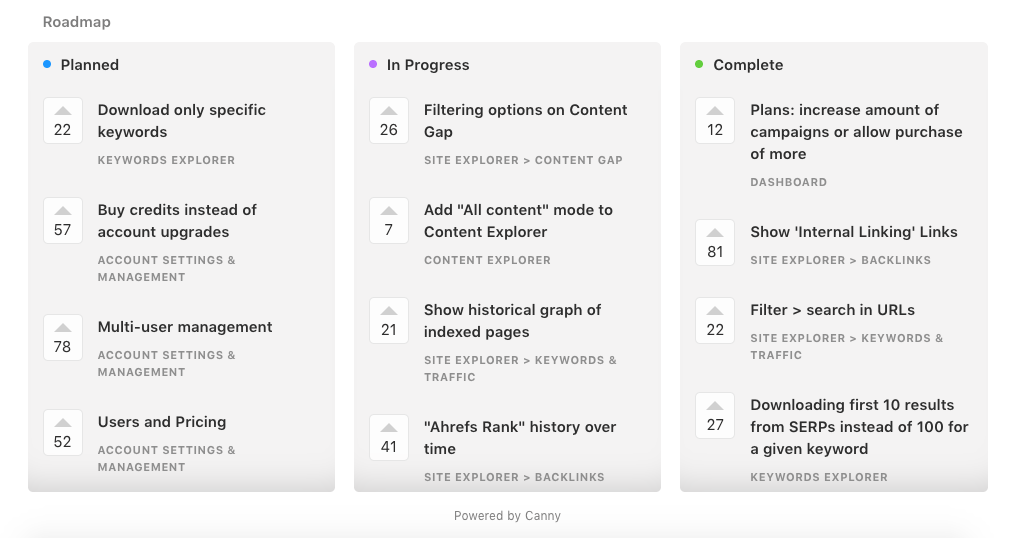
With that said, here are 6 reasons why having a public roadmap will benefit you, and help you build a better product.
6 reasons why you should have a public product roadmap
1. It offers transparency
When you have a public roadmap, you can show your customer base exactly what you’re building.
There’s hardly a better way to be transparent than by showing the world what you’re working on.
Why this matters:
Transparency is huge when it comes to driving loyalty. In one survey on the ROI of transparency, 94% of consumers said they are likely to be loyal to a brand that is transparent. And, 73% said they’d be willing to pay more to do business with a more transparent company.
We reached out to Tom Redman, head of product at Buffer. Anyone can access the Buffer roadmap; For Tom, having a public roadmap aligns with Buffer’s overall culture.
“At Buffer, we’re ‘transparent by default.’ That is, if we don’t have a compelling reason for something to be private, it’ll be shared transparently.”
– Tom
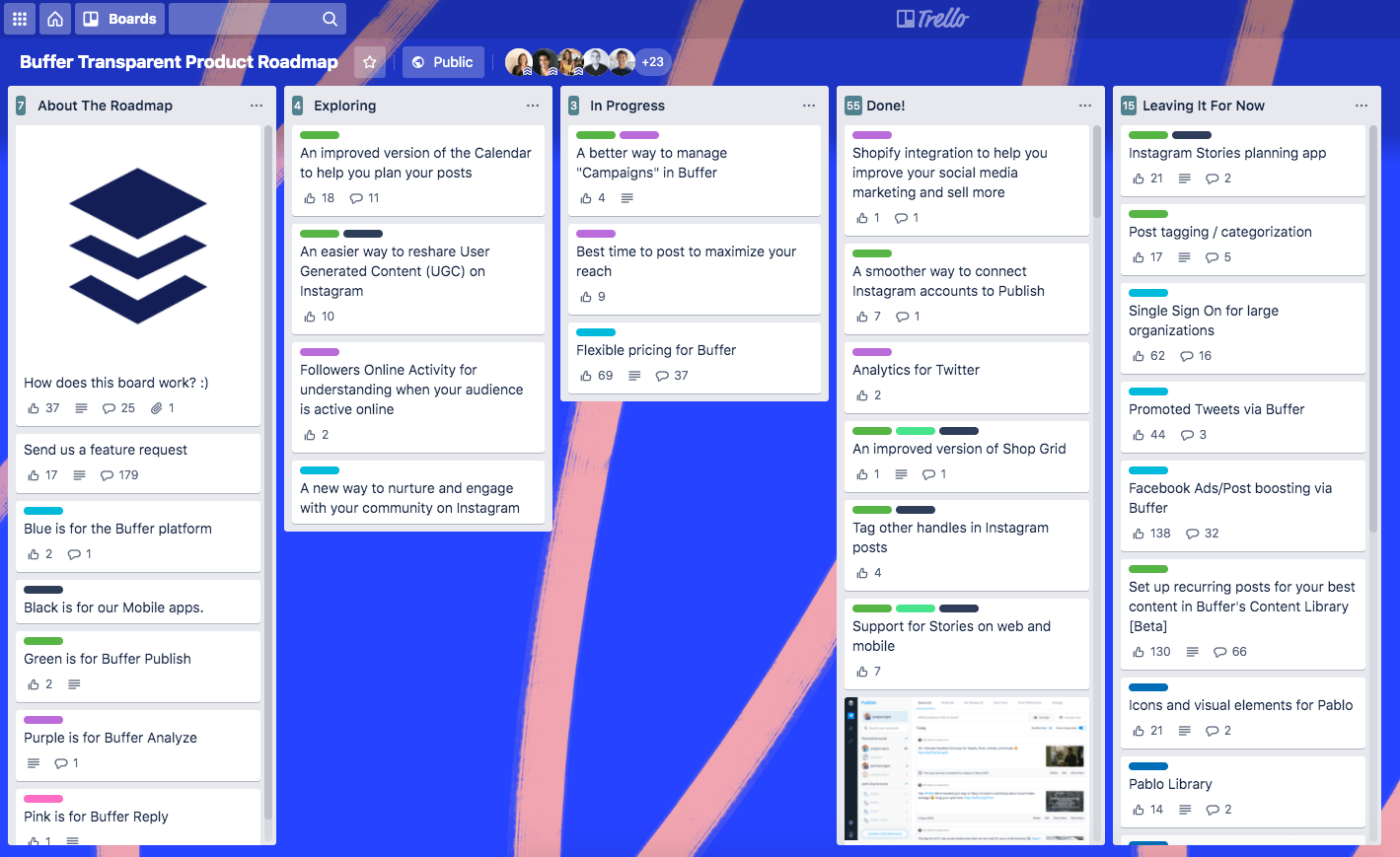
Being upfront and honest with your customers is hugely valuable. Using a roadmap to show how your company actually takes on work is a big deal. You’re giving your customers a look behind the curtain. They’ll value that level of trust and commitment to transparency.
2. It manages expectations for what you’re building (and not building)
When users can see your roadmap, they can see what your current priorities are. They’ll be able to see product direction and get a sense of your goals.
If you’re working on improving an aspect of your tool, you can show that in your roadmap. If your product doesn’t have a feature, you can show that you’re building it.
And, if you’re not building something, they’ll see that too.
Why does this matter?
If you have key planned features in the pipeline, a public roadmap gives potential users a look at what you’re building. It’s added value that your product might not have currently, but will soon.
If a current customer sees active work on a feature they really want, it can prevent churn. Similarly, a public-facing roadmap can serve as a sales tool for prospective customers. You’ll be able to show that you’re actively working on certain features that they need.
And, on the flip side, it shows if you aren’t working on a feature. Hearing a clear “no, we aren’t working on that right now” is better than not knowing.
“It’s a good way for our customers to see that their feature request is not as popular as they were hoping it would be.”
– Tim
Public roadmaps put things into perspective. You’ll be able to set expectations for what isn’t going to happen as much as what is. This helps keep your users from being disappointed or feeling left in the dark.
This is especially impactful if you’re using a product roadmapping tool like Canny with feature voting. If a suggestion has a very limited number of votes, users can better understand why you’ve decided not to add a feature to your roadmap.
3. It cuts down on questions
When your users can see what you’re working on, there’s less need to reach out with questions.
If you update your roadmap regularly, customers can easily see where you are on a certain feature. They’ll have less need to reach out and ask about progress.
Why does this matter?
You’ll lessen the load on your customer success or customer experience team, to start. The fewer customers have to ask about the status of a feature they need, the less time you need to spend updating them. And, those teams won’t have to ask the product team for that info either.
On the flip side, your users won’t have to spend valuable time reaching out to ask questions. Instead, they can just check out your roadmap (you can also update it automatically — see #5). Eliminating unnecessary hoops to jump through makes for a better customer experience.
“[Transparency] was the primary driver for us to have a public roadmap, but the practical benefit is that we can send customers or others with inquiries there to see what we’re working on, vote for, or even comment on upcoming items on the roadmap.
That’s been very helpful in sharing what our priorities are.”
– Tom
4. It shows how long things really take
You might have a very understanding customer base. They might totally get that it takes some time to build, test, and ship updates.
But, you might occasionally have to deal with frustration, too. When we want things, we often want them immediately.
When you have a public roadmap, you can lay out the steps your team takes to get from A to Z.
Users can follow along and see what’s getting done and when. And, they will have a better understanding of how long it will take for new updates or features to be introduced.
Why does this matter?
Showing how long things take offers a sense of perspective. It grounds the process. Rather than rolling out improvements seemingly at random, users can see the steps.
You’ll also be able to better manage timeline expectations. A roadmap shows that things are happening, just not overnight.
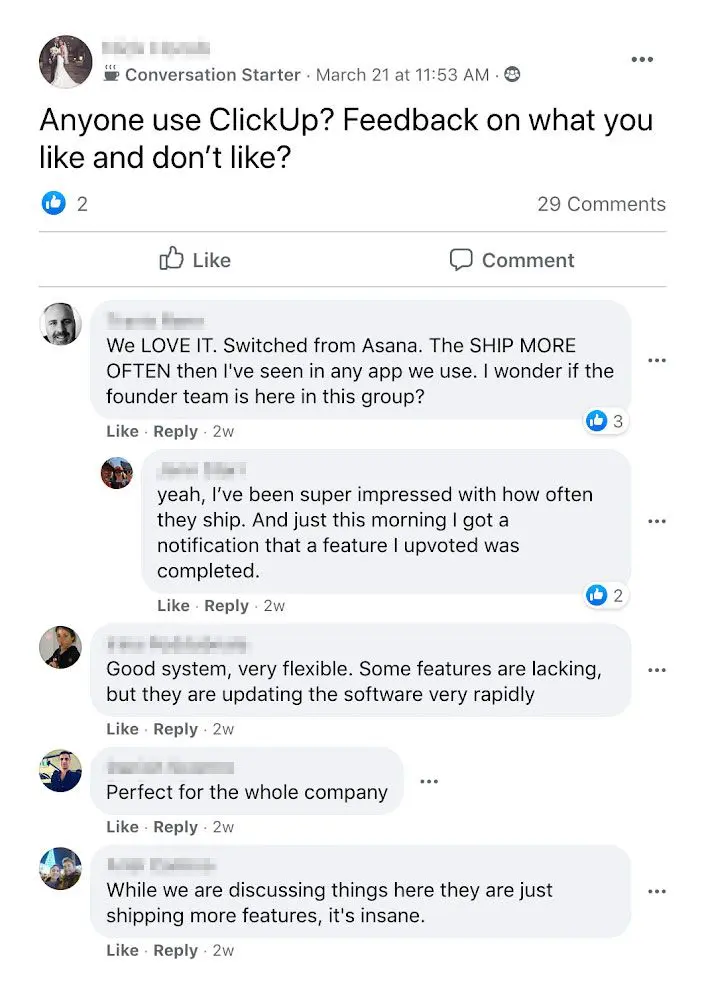
Finally, users (and prospects) will appreciate that you’re continually improving (see the conversation above from the SaaS Growth Hacks Facebook group for an example). A company that continues to iterate is more appealing than one that builds a feature set and calls it good.
“Customers (both potential and existing) appreciate feature velocity.”
– Sarah
A roadmap doesn’t just give users insight into how you work (and how long things take). It also shows that you’re continually growing and improving.
5. It’s easy to keep stakeholders updated
The work outlined on your roadmap is probably high-value. It might be a feature that you need to attract a specific type of customer. Or, it’s a fix that will make an existing important user really happy.
Regardless, you’ve likely got many different stakeholders who care deeply about what you’re working on.
A public roadmap helps involve everyone. The more you can automate the process, the less time you’ll have to spend doing it manually.
Why does this matter?
This one’s a bit obvious: it saves you time.
With some roadmaps, users are automatically updated when a roadmap item is moved to the next phase or marked as complete.
If you’re using a tool like Canny to build your roadmap , you can notify key stakeholders without taking extra steps. They’ll get notified immediately with new comments or status changes.
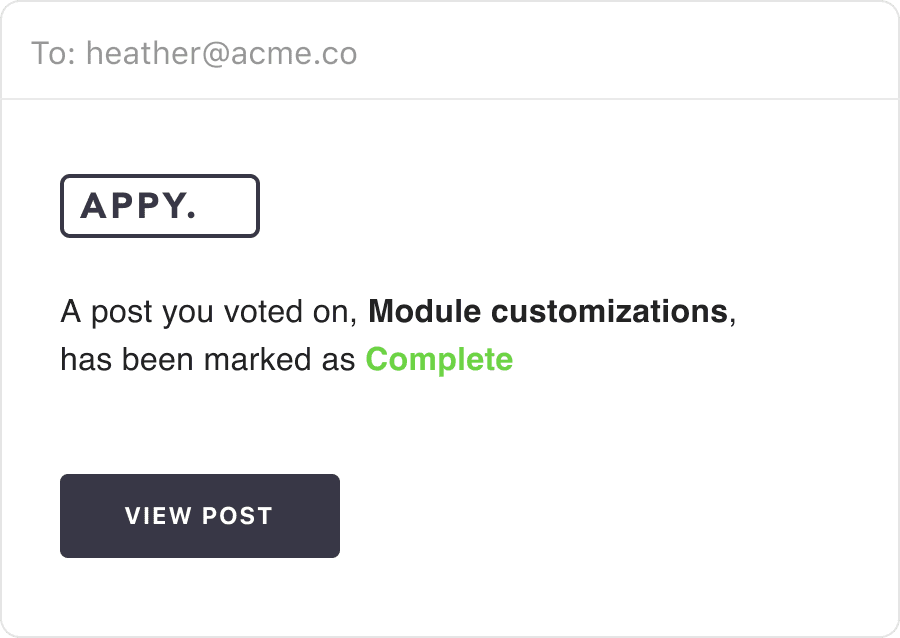
This isn’t just limited to outside stakeholders. Being able to update your internal team is also hugely valuable.
For example, your sales team might be waiting on a key feature that they know potential customers want. If they’re always looped in, they’ll be able to keep prospects updated on your timeline. And, once the feature is live, they’ll know right away, and close more deals as a result.
If you want to explore this use case in more detail, we’ve written more on the value of internal product roadmaps here.
With Canny, you can also integrate with your existing project management tools. This can be incredibly helpful for looping in different members of your team.
For instance, Canny integrates with Jira. With this integration, members of your team who aren’t working on the product can stay updated without having to log into (or even use) Jira. They’ll get the notifications they need automatically from your roadmap updates.
Of course, what you have available depends on the roadmapping tool you use. Tools like Trello, which aren’t really designed for roadmapping, won’t have these features built in.
6. It defines the process—from feedback to feature
When used in conjunction with a product feedback tool, your roadmap is a clear next step that shows how you plan to act on feedback.
Why does this matter?
Maybe you’re using a tool like Canny to collect feedback (and of course, we recommend you do). Maybe your product manager manually tracks the feedback you get and your most-requested features (we’ve also covered how to determine if you need a feedback tool).
Whatever the case, your users will want to know what you’re doing with their input. Are you actually implementing any of their requests?
Showing that you are taking feedback seriously, and using it to inform new features or fixes, is huge. It creates a loop. A user suggests a certain feature and can watch as your team works on it. This instills confidence in the feedback request process, and your company itself.
Leading companies with public roadmaps
Public roadmaps are incredibly common, especially in the SaaS space. With all the benefits we’ve outlined it’s easy to understand why.
It’s always a good idea to draw inspiration from companies following best practices. Check out our big list of public roadmap examples for more ideas.
What if I don’t have a public roadmap?
Not having a public roadmap has quite a few drawbacks. You miss out on building a community around your product, receiving early feedback, and setting clear expectations. It protects your privacy, but it’s potentially isolating.
Consider these things you’ll miss out on:
- User insight: you may miss valuable feedback that could steer your product’s direction
- Market perception: users might see your brand as less open or customer-focused
A public product roadmap offers transparency and closes the loop
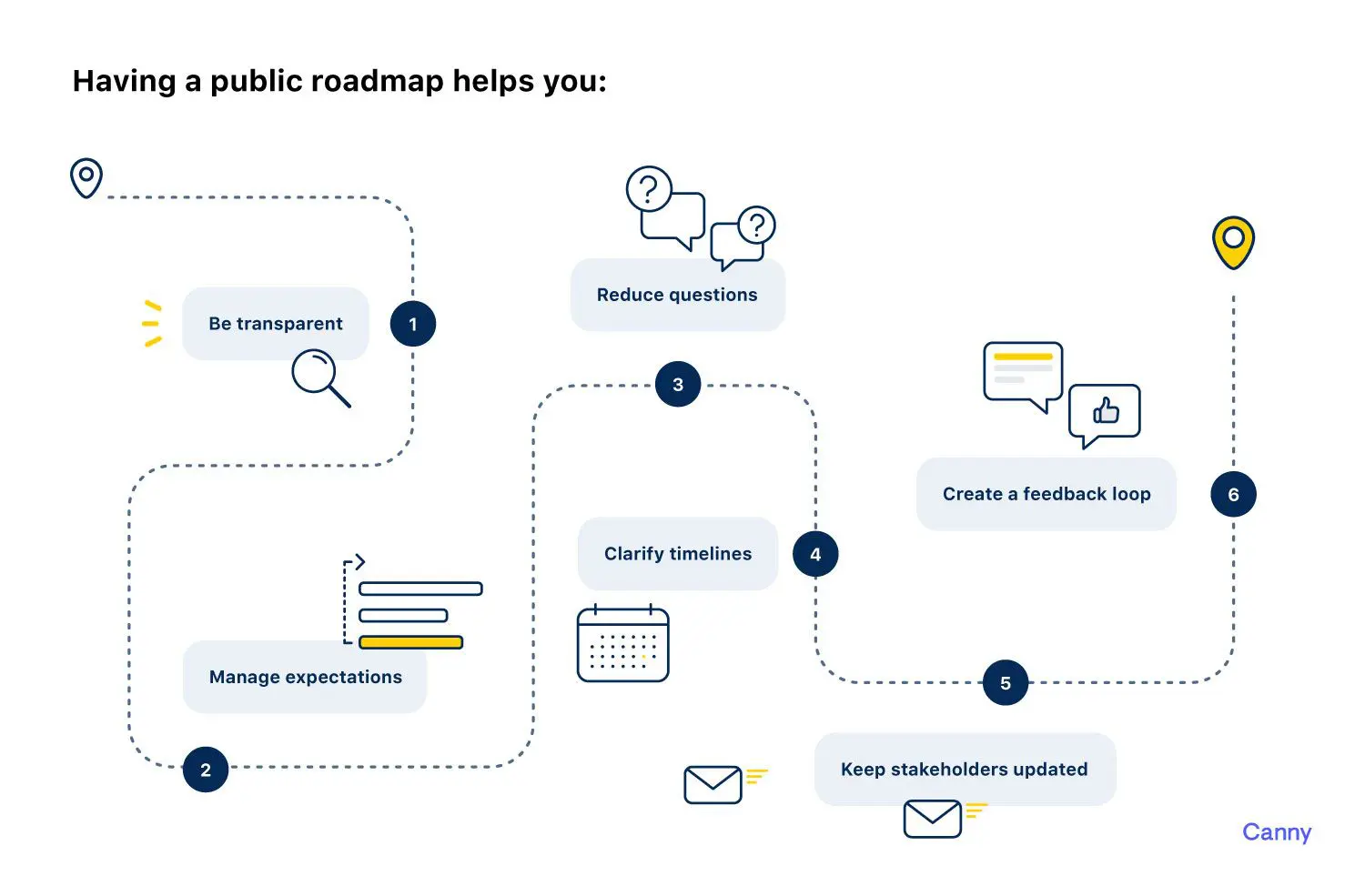
Ideally, your roadmap should be the natural next step after collecting feedback from your customers. It creates a system — user feedback becomes new features and improvements.
By publicly sharing your progress, you’ll instill confidence in your user base. Their feedback isn’t just disappearing into the ether. You’re actually doing something with it.
Does your team have a public roadmap? Why or why not? Let us know in the comments, or tell us on Twitter.



